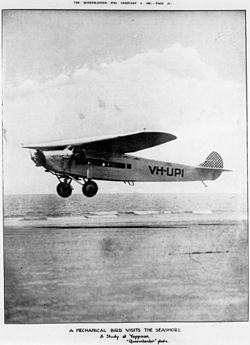1933 Imperial Airways Ruysselede crash
 An Avro Ten, similar to the accident aircraft. | |
| Accident | |
|---|---|
| Date | 30 December 1933 |
| Summary | Pilot error (CFIT) |
| Site | Ruysselede, West Flanders, Belgium 51°4′41.98″N 3°20′5.44″E / 51.0783278°N 3.3348444°ECoordinates: 51°4′41.98″N 3°20′5.44″E / 51.0783278°N 3.3348444°E |
| Aircraft | |
| Aircraft type | Avro Ten |
| Aircraft name | Apollo |
| Operator | Imperial Airways |
| Registration | G-ABLU |
| Flight origin | Cologne Butzweilerhof Airport, Germany |
| Stopover | Haren Airport, Brussels, Belgium |
| Destination | Croydon Airport, United Kingdom |
| Passengers | 8 |
| Crew | 2 |
| Fatalities | 10 |
| Survivors | 0 |
The 1933 Imperial Airways Ruysselede crash occurred on 30 December 1933 when an Imperial Airways Avro Ten collided with one of the radio mast of Belradio at Ruysselede, West Flanders, Belgium and crashed killing all ten people on board. The aircraft was operating an international scheduled passenger flight from Cologne, Germany to London, England via Brussels, Belgium.
Aircraft[]
The accident aircraft was Avro Ten registration G-ABLU, c/n 528. The aircraft had entered service with Imperial Airways in May 1931 and having served for a time with Iraq Petroleum Transport Co., it had returned to Imperial Airways. The aircraft was named Apollo.[1]
Accident[]
Operating a flight from Cologne, Germany to Croydon Airport, United Kingdom via Haren Airport, Brussels, Belgium, the aircraft departed at 12:20 local time (11:20 GMT), which was 20 minutes later than scheduled. As a result of fog, the aircraft was flying on a route to the north of its normal route. At 13:15,[2] whilst flying at an altitude of 250 feet (76 m),[3] it crashed into a guy wire of the 870 feet (270 m) tall radio mast at Ruysselede,[2][4] which was illuminated at the time. The top section of the mast was demolished. The aircraft lost a wing and crashed. Four workers at the radio station rushed to the aid of those on board the aircraft, as did twelve villagers from Ruysselede. At least one passenger was seen to have survived the crash. There was an explosion and the wreckage of the aircraft was burnt out. The rescuers all suffered burns.[2]
Casualties[]
All ten passengers and crew on the aircraft were killed. Four rescuers suffered burns.[2]
| Nationality | Crew | Passengers | Total |
|---|---|---|---|
| United Kingdom | 2 | 5 | 7 |
| Netherlands | – | 2 | 2 |
| Poland | – | 1 | 1 |
| Total | 2 | 8 | 10 |
Investigation[]
The accident was investigated by Belgian authorities. The British Accidents Investigation Branch sent a representative to assist in the investigation.[5]
Awards[]
The relatives of one of the victims praised the bravery of one of the rescuers, and pressed for him to be rewarded for his courage.[6] King Albert I awarded Camille van Hove the Civic Cross (1st Class) for his efforts in attempting to rescue the victims of the crash. Mr van Hove received serious burns and was still in hospital in Bruges at the time the award was notified.[4][7] Nine other rescuers were given rewards of money.[8]
References[]
- ^ "Civil Aircraft Register – Great Britain". Golden Years of Aviation. Retrieved 16 April 2014.
- ^ a b c d "Air Crash in Belgium". The Times (46640). London. 1 January 1934. col D, p. 12. template uses deprecated parameter(s) (help)
- ^ "Imperial Airways machine crashes in fog". Flight (4 January 1934): 17.
- ^ a b "The Air Liner Crash". The Times (46644). London. 5 January 1934. col B, p. 11. template uses deprecated parameter(s) (help)
- ^ "Wrecked Air Liner". The Times (46441). London. 2 January 1934. col E, p. 9. template uses deprecated parameter(s) (help)
- ^ "Air Crash in Belgium". The Times (46642). London. 3 January 1934. col G, p. 9. template uses deprecated parameter(s) (help)
- ^ "Civil Cross for Ruysselede crash rescuer". Flight (11 January 1934): 41.
- ^ "The Apollo Disaster". The Times (46657). London. 20 January 1934. col B, p. 10. template uses deprecated parameter(s) (help)
External links[]
- Photograph of G-ABLU Apollo and Handley Page H.P.42 G-AAUD Hanno.
- Aviation accidents and incidents in 1933
- Aviation accidents and incidents in Belgium
- Airliner accidents and incidents involving fog
- Imperial Airways accidents and incidents
- 1933 in aviation
- 1933 in Belgium
